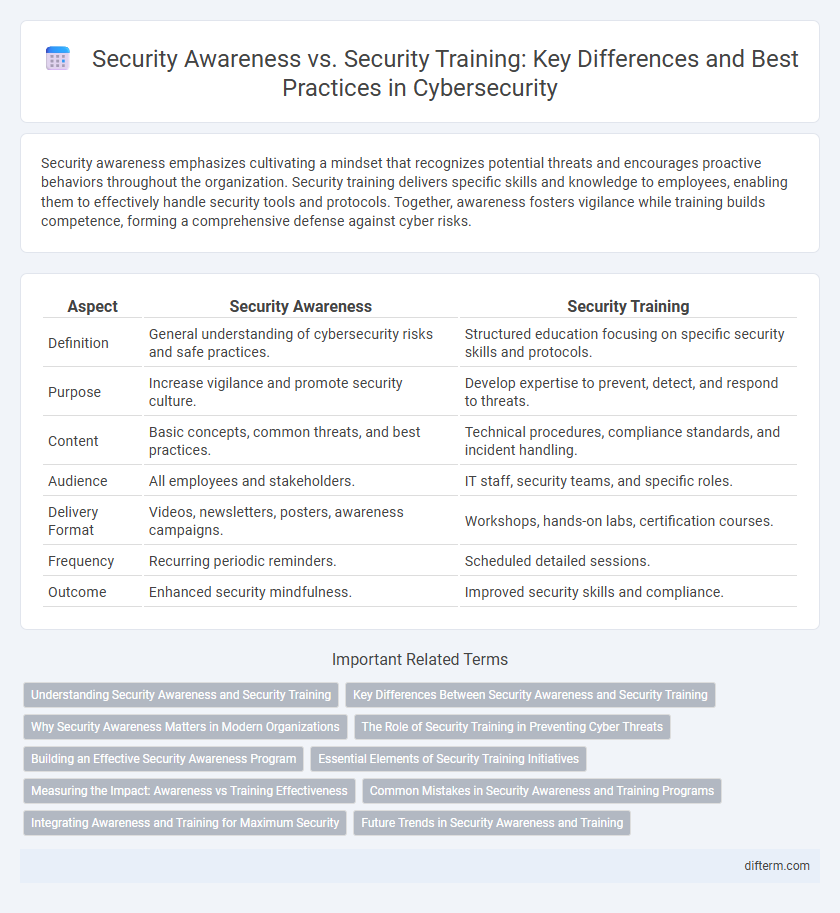Security awareness emphasizes cultivating a mindset that recognizes potential threats and encourages proactive behaviors throughout the organization. Security training delivers specific skills and knowledge to employees, enabling them to effectively handle security tools and protocols. Together, awareness fosters vigilance while training builds competence, forming a comprehensive defense against cyber risks.
Table of Comparison
| Aspect | Security Awareness | Security Training |
|---|---|---|
| Definition | General understanding of cybersecurity risks and safe practices. | Structured education focusing on specific security skills and protocols. |
| Purpose | Increase vigilance and promote security culture. | Develop expertise to prevent, detect, and respond to threats. |
| Content | Basic concepts, common threats, and best practices. | Technical procedures, compliance standards, and incident handling. |
| Audience | All employees and stakeholders. | IT staff, security teams, and specific roles. |
| Delivery Format | Videos, newsletters, posters, awareness campaigns. | Workshops, hands-on labs, certification courses. |
| Frequency | Recurring periodic reminders. | Scheduled detailed sessions. |
| Outcome | Enhanced security mindfulness. | Improved security skills and compliance. |
Understanding Security Awareness and Security Training
Security Awareness involves educating employees on recognizing potential threats and fostering a security-conscious culture, while Security Training provides specific skills and protocols to effectively respond to security incidents. Understanding Security Awareness emphasizes mindset and behavior changes, whereas Security Training focuses on technical knowledge and practical application of security measures. Both components are crucial for an organization's comprehensive cybersecurity strategy, ensuring personnel can both identify risks and implement defensive actions.
Key Differences Between Security Awareness and Security Training
Security awareness emphasizes cultivating a general understanding of cybersecurity risks and promoting vigilant behavior among employees, while security training delivers specialized, role-specific knowledge and technical skills to effectively handle security threats. Security awareness initiatives deploy broad campaigns like phishing simulations and informational content, whereas security training involves structured programs such as hands-on exercises, policy education, and compliance courses. The primary difference lies in awareness fostering a security-conscious culture, whereas training equips individuals to execute protective measures accurately within their job functions.
Why Security Awareness Matters in Modern Organizations
Security awareness is essential in modern organizations because it fosters a culture of vigilance, reducing the risk of cyber threats caused by human error. Employees educated through awareness programs recognize phishing attempts, social engineering, and other cyber risks, enhancing overall organizational resilience. Continuous security awareness initiatives lead to proactive behavior changes, significantly decreasing the likelihood of data breaches and financial losses.
The Role of Security Training in Preventing Cyber Threats
Security training plays a critical role in preventing cyber threats by equipping employees with practical skills to recognize and respond to attacks such as phishing, ransomware, and social engineering. Unlike general security awareness, which focuses on knowledge dissemination, security training involves hands-on exercises and simulations that reinforce proper security behavior and incident response protocols. Effective security training programs significantly reduce human errors, making organizations more resilient against evolving cyber risks.
Building an Effective Security Awareness Program
Building an effective security awareness program requires distinguishing it from traditional security training by emphasizing continuous engagement and behavioral change rather than one-time instruction. Security awareness programs leverage interactive tools, real-world scenarios, and regular updates to foster a culture of vigilance and proactive threat recognition among employees. Incorporating metrics and feedback loops enhances the program's ability to adapt and address evolving cybersecurity risks efficiently.
Essential Elements of Security Training Initiatives
Effective security training initiatives encompass clear role-based instructions, hands-on simulations, and regular assessments to reinforce knowledge retention and behavioral change. Incorporating threat recognition, policy comprehension, and incident response protocols ensures employees develop practical skills to mitigate risks. Continuous updates aligned with emerging cyber threats maintain the relevance and efficacy of security training programs.
Measuring the Impact: Awareness vs Training Effectiveness
Measuring the impact of security awareness versus security training involves analyzing behavioral changes and incident reduction rates within an organization. Security awareness initiatives primarily enhance recognition of threats and promote vigilance, while training effectiveness is gauged by employees' ability to apply security protocols and respond to specific scenarios accurately. Key performance indicators such as phishing simulation success rates, compliance scores, and post-training assessments provide quantitative data to differentiate the outcomes of awareness campaigns from formal training programs.
Common Mistakes in Security Awareness and Training Programs
Common mistakes in security awareness and training programs include relying solely on annual training sessions without ongoing reinforcement, which leads to poor retention of critical security protocols. Another frequent error is generic content that fails to address specific organizational risks, reducing the relevance and effectiveness of the training. Neglecting to measure and adapt programs based on employee feedback and threat landscape changes results in outdated practices that do not adequately mitigate modern cybersecurity threats.
Integrating Awareness and Training for Maximum Security
Integrating security awareness and security training enhances organizational defense by combining broad understanding with practical skills, fostering a security-conscious culture. Security awareness programs inform employees about threats and policies, while targeted training provides hands-on experience to respond effectively. This synergy ensures maximum security by aligning knowledge with actionable behaviors across all levels of the organization.
Future Trends in Security Awareness and Training
Emerging technologies such as AI-driven simulations and gamified learning platforms are revolutionizing security awareness and training by providing personalized, adaptive experiences that enhance user engagement and retention. Future trends emphasize continuous, real-time education integrated with behavioral analytics to identify vulnerabilities and tailor training content dynamically. The convergence of immersive virtual reality environments and automated threat intelligence is expected to create proactive, context-aware security awareness programs that bolster organizational resilience against evolving cyber threats.
Security Awareness vs Security Training Infographic

 difterm.com
difterm.com